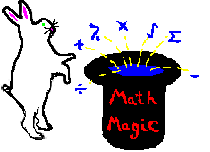

A. From algebra we learn:
1 + 1 + 1 . = 3 .
n(n+1) (n+1)(n+2) (n+2)(n+3) (n+1)(n+2) – 2
B. Use the following rules:
1. The numerator to the answer is always 3.
2. The denominator to the answer is the second denominator minus 2.
3. Make sure that the fraction is in simplest terms.
Ex [1] 1 + 1 + 1 =
6 12 20 (fraction).
a) Notice this follows the pattern since the first denominator is 2 x 3, the second is 3 x 4, and the last is 4 x 5.
b) The numerator is 3.
c) The denominator is 12 – 2 or 10.
d) The answer is 3/10.
Ex [2] 1 + 1 + 1 =
42 56 72 (fraction).
a) Notice this follows the pattern since the first denominator is 6 x 7, the second is 7 x 8, and the last is 8 x 9.
b) The numerator is 3.
c) The denominator is 56 – 2 or 54.
d) The answer is 3/54. However, we must reduce this fraction to 1/18.
e) The final answer is 1/18.